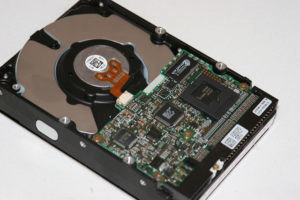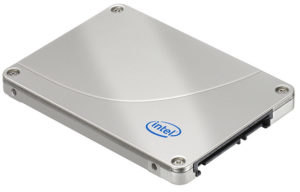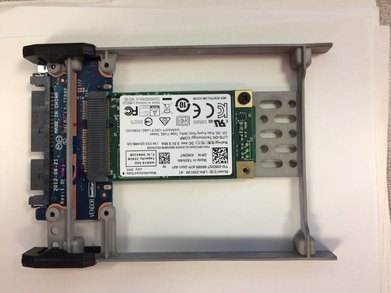

WHAT IS A SOLID-STATE DRIVE?
In order to get a handle on what a Solid-State Drive is, we need to sort of understand what the term “solid state” means. In short, when we say “solid state,” we mean electronic circuitry that is built entirely of semiconductors. It may help to understand what NOT “solid state” would be. Older televisions and radios used vacuum tubes. I’m barely old enough to remember having to let the television and radio “warm up” before they started producing sound and pictures. The “older” version of computer hard drives use spinning magnetic discs. I put “older” in quotes because spinning hard drives, or mechanical hard drives, are not yet obsolete. You’ll see why in just a few minutes.
In the images above, the top drive is a spinning mechanical hard drive, and the bottom one shows a solid state drive. In the top image, you can see the rows of pins on one end of the device. That is the older Integrated Drive Electronics (or IDE) connector. Newer drives like the one below use a Serial ATA or SATA connector, and it looks like this:

The long slot is to put power to the drive and the short slot is the data transfer connection. In a desktop computer, you would attach the two cables, one for power, one for data, to the connection points on the drive. In a laptop, the connectors are static, and you just slide the drive into the slot, just like you would a spinning mechanical drive.
HOW NEW IS SOLID-STATE DRIVE TECHNOLOGY?
Solid-state drives have been around for a while. The first ones were built in the 1960’s, and capacity was measured in kilobytes. In the 70’s and 80’s, SSDs used small magnetic tape drives as backups. Much progress has been made in the technology to produce the drives at a lower cost. In 1996, the prices ranged from $8,000 to $100,000 for a drive, depending on capacity and application. Although the prices have come down to consumer levels, price is still an impediment to widescale adoption into personal computers and electronics.
IS SOLID-STATE DRIVE TECHNOLOGY REALLY VERY DIFFERENT FROM MY REGULAR HARD DRIVE?
A solid-state drive is a lot like the flash memory of a USB thumb drive. The physical design is different so that it can accommodate more storage capacity and to fit into the internal slots of a laptop or desktop drive bay.
The newest designs of SSDs are called an M.2 module, and they look like a memory chip. The image below shows one of these M.2 modules in an adapter that will allow it to fit into a laptop “normally.” Newer motherboards have a special slot for these modules. Some systems actually have them integrated into the board itself.

SSDs have no moving parts, and the data is stored in blocks on the chips. Having no moving parts, the drive is less likely to suffer damage from impact. And because the data is stored in blocks, there is no need to defragment the drive, and in fact a solid state drive should not be defragmented.
There are some valid reasons to transition from spinning drives to SSDs. Because it doesn’t spin, it doesn’t get hot, so it won’t need as much power to run the fan. Additionally, the drive itself doesn’t need as much power to run, because there are no discs to spin. The process of spinning up a hard drive can produce a lot of wear and tear on the drive, and that just doesn’t happen with an SSD.
Solid-state drives are blazing fast. Booting a computer fully into the operating system is measurably quicker with a solid-state drive than with a mechanical drive. Applications launch much faster, and there is no lag in opening and saving documents. File copy speeds are faster. Data access speeds have no latency. This makes SSDs particularly suitable for resource-intensive use like CAD, CAM, relational database management, geospatial work, statistical analysis, and video on demand.
WHY AREN’T WE SEEING MORE SOLID-STATE DRIVE ADOPTION?
There are also some legitimate barriers to universal SSD adoption. One is cost. The cost per GB of capacity is significantly higher than that of a mechanical drive. Comparing a mechanical drive cost with a solid state drive of similar or identical capacity will show a much higher cost for the SSD. We see, as well, that with larger capacity SSDs, we see a greater cost, which is the opposite of what we see with mechanical drives.
Some of that cost can be mitigated in the type of SSD purchased. SSD drives use either MultiLevel Cell (MLC) memory or Single Level Cell (SLC) memory. Multilevel cell memory can store more information per cell than single level cell, but the cost of that capacity is a higher error rate. MLC memory does use Error Correcting Code to mitigate those errors.
SOLID-STATE DRIVE WRITE AND SIZE LIMITS
While the mechanical drive has a life span limited by the wear and tear on the moving parts, and the SSD has no moving parts, it is not true that an SSD has an unlimited life span. Flash-type memory has a limited number of write cycles. If you were to write data to a smaller-capacity flash drive repeatedly, you would eventually find that the drive would no longer let you write to it. You could still read from it, but you would not be able to write to it. When I’ve experienced that, I save the data from the thumb drive and format the drive. Not such a big deal with it’s a few files. Howeverr, when the drive is your operating system drive, you may not want to format that drive very often. It is this limitation on the write cycles that makes it undesirable to defragment the hard drive. Every action in the defragmentation process is a write process to the hard drive.
Capacity is another impediment to rapid adoption in the computer markets. Mechanical drives are now averaging between 500 GB and 1 TB for a standard notebook or desktop. A computer with an SSD will likely have only 128 to 256 of storage capacity.
Rick Coulson, a senior fellow at Intel Corp. said, “You have to have a performance reason for solid-state drives to make sense…Am I going to put [a solid-state drive] inot an SQL database? Absolutely not.”
SOLID-STATE DRIVE ADOPTION
Back in 2008, Gregory Gum, an engineering specialist with The Aerospace Corp., predicted that it would take at least five years for solid-state memory (or drives) to be widely deployed. He wasn’t far off, by 2013 SSD’s were a somewhat expensive upgrade for most models of laptops, and today SSD is the preferred choice at least for the operating system drive.
Many users like having their operating system and programs on a solid state drive, and their data on a mechanical drive. The cost of mechanical drives makes it easy to justify a really big data storage drive. Even though the data access for the mechanical drive is slower than it is on the solid state drive, the speed of the SSD still makes this configuration much faster than the system will be using only mechanical drives.
Western Digital (this is not an endorsement or an advertisement, and I am not receiving any consideration for my statement here) has produced a really interesting-looking hybrid drive. It’s the Western Digital Black dual drive. It combines a 120 GB SSD and a 1 TB mechanical hard drive onto the same body. And unlike other hybrid drive systems, each drive will appear as a separate drive on your system. So using this one device you would have both a C:\ and an E:\ drive, and you would load the operating system and applications onto the C:\ drive and store your data on the E:\ drive. This drive is neither the fastest nor the lowest-priced drive on the market–it is still over $200–but it can be an acceptable solution when you need both speed and capacity but only have one drive bay available.
SO DO I STILL NEED TO BE REALLY CAREFUL WITH MY DATA?
A word of caution: Solid State drives CAN FAIL! And when they fail, they fail just as hard as mechanical drives do. As with any computer system–or any technology that stores data–YOU NEED A BACKUP. YOU NEED A BACKUP. YOU NEED A BACKUP. And in case I’m being too subtle, YOU NEED A BACKUP. And to use the Hybrid drive, both drives would need to be backed up, because if one of the drives fails, the whole thing needs to be replaced.
Have you jumped to a solid state drive? What has it done for you? If not, what’s holding you back? (in my case, I need to take the time to do it, and it will take a whole weekend because I have a huge hard drive full of programs.)